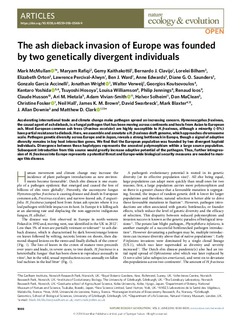| dc.contributor.author | McMullan, Mark | |
| dc.contributor.author | Rafiqi, Maryam | |
| dc.contributor.author | Kaithakottil, Gemy | |
| dc.contributor.author | Clavijo, Bernardo J | |
| dc.contributor.author | Bilham, Lorelei | |
| dc.contributor.author | Orton, Elizabeth | |
| dc.contributor.author | Percival-Alwyn, Lawrence | |
| dc.contributor.author | Ward, Ben J | |
| dc.contributor.author | Edwards, Anne | |
| dc.contributor.author | Saunders, Diane GO | |
| dc.contributor.author | Accinelli, Gonzalo Garcia | |
| dc.contributor.author | Wright, Jonathan | |
| dc.contributor.author | Verweij, Walter | |
| dc.contributor.author | Koutsovoulos, Georgios | |
| dc.contributor.author | Yoshida, Kentaro | |
| dc.contributor.author | Hosoya, Tsuyoshi | |
| dc.contributor.author | Williamson, Louisa | |
| dc.contributor.author | Jennings, Philip | |
| dc.contributor.author | Ioos, Renaud | |
| dc.contributor.author | Husson, Claude | |
| dc.contributor.author | Hietala, Ari Mikko | |
| dc.contributor.author | Vivian-Smith, Adam | |
| dc.contributor.author | Solheim, Halvor | |
| dc.contributor.author | MaClean, Dan | |
| dc.contributor.author | Fosker, Christine | |
| dc.contributor.author | Hall, Neil | |
| dc.contributor.author | Brown, James KM | |
| dc.contributor.author | Swarbreck, David | |
| dc.contributor.author | Blaxter, Mark | |
| dc.contributor.author | Downie, J Allan | |
| dc.contributor.author | Clark, Matthew D | |
| dc.date.accessioned | 2018-05-31T08:10:28Z | |
| dc.date.available | 2018-05-31T08:10:28Z | |
| dc.date.created | 2018-05-30T15:16:44Z | |
| dc.date.issued | 2018-04-23 | |
| dc.identifier.citation | Nature Ecology & Evolution. 2018, 2 1000-1008. | nb_NO |
| dc.identifier.issn | 2397-334X | |
| dc.identifier.uri | http://hdl.handle.net/11250/2499856 | |
| dc.description.abstract | Accelerating international trade and climate change make pathogen spread an increasing concern. Hymenoscyphus fraxineus, the causal agent of ash dieback, is a fungal pathogen that has been moving across continents and hosts from Asian to European ash. Most European common ash trees (Fraxinus excelsior) are highly susceptible to H. fraxineus, although a minority (~5%) have partial resistance to dieback. Here, we assemble and annotate a H. fraxineus draft genome, which approaches chromosome scale. Pathogen genetic diversity across Europe and in Japan, reveals a strong bottleneck in Europe, though a signal of adaptive diversity remains in key host interaction genes. We find that the European population was founded by two divergent haploid individuals. Divergence between these haplotypes represents the ancestral polymorphism within a large source population. Subsequent introduction from this source would greatly increase adaptive potential of the pathogen. Thus, further introgression of H. fraxineus into Europe represents a potential threat and Europe-wide biological security measures are needed to manage this disease. | nb_NO |
| dc.language.iso | eng | nb_NO |
| dc.publisher | Springer Nature | nb_NO |
| dc.rights | Navngivelse 4.0 Internasjonal | * |
| dc.rights.uri | http://creativecommons.org/licenses/by/4.0/deed.no | * |
| dc.subject | Population genetics | nb_NO |
| dc.subject | Ecological genetics | nb_NO |
| dc.title | The ash dieback invasion of Europe was founded by two genetically divergent individuals | nb_NO |
| dc.type | Journal article | nb_NO |
| dc.type | Peer reviewed | nb_NO |
| dc.description.version | publishedVersion | nb_NO |
| dc.rights.holder | © 2018 Macmillan Publishers Limited, part of Springer Nature. All rights reserved. | nb_NO |
| dc.source.pagenumber | 1000-1008 | nb_NO |
| dc.source.volume | 2 | nb_NO |
| dc.source.journal | Nature Ecology & Evolution | nb_NO |
| dc.identifier.doi | 10.1038/s41559-018-0548-9 | |
| dc.identifier.cristin | 1587829 | |
| cristin.ispublished | true | |
| cristin.fulltext | original | |
| cristin.qualitycode | 0 | |

